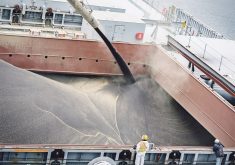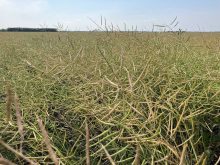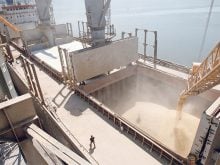In crisis is opportunity, and opportunities from the ongoing world financial crisis are beginning to bear fruit for Buhler Industries.
The company has been gobbling up smaller farm equipment manufacturers, investing in the next generation of heavy machinery and expanding its shadow over a wider range of products.
“There are opportunities,” chief operating officer Grant Adolph said in an interview during the unveiling of the company’s new Versatile four-wheel drive, Tier 4 tractor.
“If there is a crisis, there are companies that get in trouble, so we have been very smart (in buying quality companies that are for sale).”
Read Also

Short rapeseed crop may put China in a bind
Industry thinks China’s rapeseed crop is way smaller than the official government estimate. The country’s canola imports will also be down, so there will be a lot of unmet demand.
The company hasn’t used debt or equity issues to buy companies such as Ezee-On Manufacturing or invest in developing a new 550 horsepower, low emissions tractor. Instead, it used cash from profits.
That was made easier by the company’s choice to suspend its dividend soon after Russian manufacturer Rostselmash bought majority control of the company in 2007.
Instead of sending money to shareholders, it kept the money inside the company, something many companies did during the world financial crisis and slump of 2008.
It has not reinstituted the dividend and instead has spent the money on expanding the company and its offerings, using its internal financial health as leverage against other companies’ troubles.
“We took that as an opportunity to basically finance some of the purchases that we have done,” said Adolph.
“We have always been a profitable company (since becoming a publicly traded company) and that’s one of the things we can pride ourselves on.”
The new tractor, which was forced by U.S. pollution emission control standards, cost “many millions of dollars,” Adolph said.
However, the company’s financial health allowed it to go beyond redesigning the engine to also radically improving the cab, alleviating a leading criticism of Versatile tractors.
“A tractor like this is a huge investment and we have spent a lot of money on development, on tooling, and it’s going to take some years to pay that back, but that’s what we’ve done,” said Adolph.
Buhler Industries is profitable this year, a common situation among farm machinery manufacturers. It had revenue of almost $200 million in the nine months ending June 30, 2011, compared to $152.4 million in same period the previous year.
However, president Dmitry Lyubimov said it hasn’t been an easy period to manage.
Manufacturing is a long process, and matching production runs to future demand has been difficult.
“We receive parts from all over the world … but it’s never perfect,” he said in an interview.
“You either have too much product, such as two years ago, and not enough demand, or like this year: too much demand and not enough product. It’s never perfect.”
However, Buhler believes stable earnings and profits can keep it growing in an era of tight finance and high commodity prices.
The former creates acquisition opportunities and the latter produces growing demand for farm machinery.
Adolph said his company now spends proportionately more on research and development than Agco or Case New Holland and about the same as Deere and Company, based on sales revenues.
“That shows a fair commitment to the future,” said Adolph, promising new sprayers, tillage equipment and air seeders for row crop farmers.















